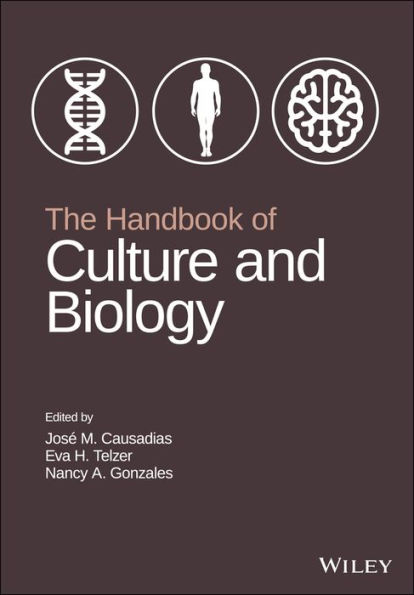
The Handbook of Culture and Biology
560
The Handbook of Culture and Biology
560eBook
Available on Compatible NOOK devices, the free NOOK App and in My Digital Library.
Related collections and offers
Overview
Culture and biology are considered as two domains of equal importance and constant coevolution, although they have traditionally been studied in isolation. The Handbook of Culture and Biology is a comprehensive resource that focuses on theory and research in culture and biology interplay. This emerging field centers on how these two processes have evolved together, how culture, biology, and environment influence each other, and how they shape behavior, cognition, and development among humans and animals across multiple levels, types, timeframes, and domains of analysis.
The text provides an overview of current empirical and theoretical advances in culture and biology interplay research through the work of some of the most influential scholars in the field. Harnessing insights from a range of disciplines (e.g., biology, neuroscience, primatology, psychology) and research methods (experiments, genetic epidemiology, naturalistic observations, neuroimaging), it explores diverse topics including animal culture, cultural genomics, and neurobiology of cultural experiences. The authors also advance the field by discussing key challenges and limitations in current research.
The Handbook of Culture and Biology is an important resource that:
- Gathers related research areas into the single, cohesive field of culture and biology interplay
- Offers a unique and comprehensive collection from leading and influential scholars
- Contains information from a wide range of disciplines and research methods
- Introduces well-validated and coherently articulated conceptual frameworks
Written for scholars in the field, this handbook brings together related areas of research and theory that have traditionally been disjointed into the single, cohesive field of culture and biology interplay.

Product Details
| ISBN-13: | 9781119181354 |
|---|---|
| Publisher: | Wiley |
| Publication date: | 08/30/2017 |
| Sold by: | JOHN WILEY & SONS |
| Format: | eBook |
| Pages: | 560 |
| File size: | 1 MB |
About the Author
Eva H. Telzer is an Assistant Professor of Psychology and Neuroscience at the University of North Carolina Chapel Hill. She researches how cultural processes shape brain development, with a focus on family and peer relationships and long-term psychological well-being.
Nancy A. Gonzales is Foundation Professor of Psychology at Arizona State University. She studies the role of culture in children's development, psychopathology and resilience.
Read an Excerpt
Table of Contents
Foreword: On culture and biology.Kevin Laland.Preface: Why culture and biology?José M. Causadias.
Part 1: General issues in culture and biology interplay
Chapter 1: Introduction to culture and biology interplay.José M. Causadias, Eva H. Telzer, and Nancy A. Gonzales.
Chapter 2: Integrating culture and biology in psychological research: Conceptual clarifications and recommendations.Moin Syed and Ummul-Kiram Kathawalla.
Chapter 3: Understanding religion from cultural and biological perspectives.Stefanie Northover and Adam B. Cohen.
Part 2: Animal Culture
Chapter 4: Introduction to animal culture: Is culture uniquely human?Charles Snowdon.
Chapter 5. Comparing and contrasting primate and cetacean culture.Jennifer Botting, Erica van de Waal, and Luke Rendell.
Chapter 6. Cultural phenomena in cooperatively breeding primates.Charles Snowdon.
Part 3: Cultural genomics
Chapter 7: How are genes related to culture? An introduction to the field of cultural genomics.José M. Causadias and Kevin Korous.
Chapter 8: Dual inheritance, cultural transmission, and niche construction.Michael J. O’Brien and R. Alexander Bentley.
Chapter 9: How the study of religion and culture informs genetics and vice versa.Ronda F. Lo and Joni Y. Sasaki.
Part 4: Cultural Neurobiology
Chapter 10: Introduction to cultural neurobiology: Evidence from physiological systems.Leah D. Doane, Michael R. Sladek, and Emma K. Adam.
Chapter 11: The relationship among culture, poverty, stress, and allostatic load.Stacey N. Doan and Gary W. Evans.
Chapter 12: Biological consequences of unfair treatment: A theoretical and empirical review.Anthony Ong, Saarang Deshpande, and David Williams.
Chapter 13: Cultural experiences, social ties, and stress: Focusing on the HPA axis.Shu-wen Wang and Belinda Campos.
Chapter 14: Cultural influences on parasympathetic activity.LaBarron Hill and Lori S. Hoggard.
Chapter 15: Neurobiology of stress and drug use vulnerability in culturally diverse communities.Ezemenari M. Obasi, Kristin A. Wilborn, Lucia Cavanagh, Sandra Yan, & Ewune Ewane
Part 5: Cultural Neuroscience
Chapter 16: An introduction to cultural neuroscience.Lynda Lin and Eva H. Telzer.
Chapter 17: Neurobiological causes and consequences of cultural differences in social cognition.Meghan L. Meyer
Chapter 18: Culture and self-other overlap in neural circuits.Michael E. W. Varnum and Ryan S. Hampton.
Chapter 19: Developmental cultural neuroscience: Progress and prospect.Yang Qu and Eva H. Telzer.
